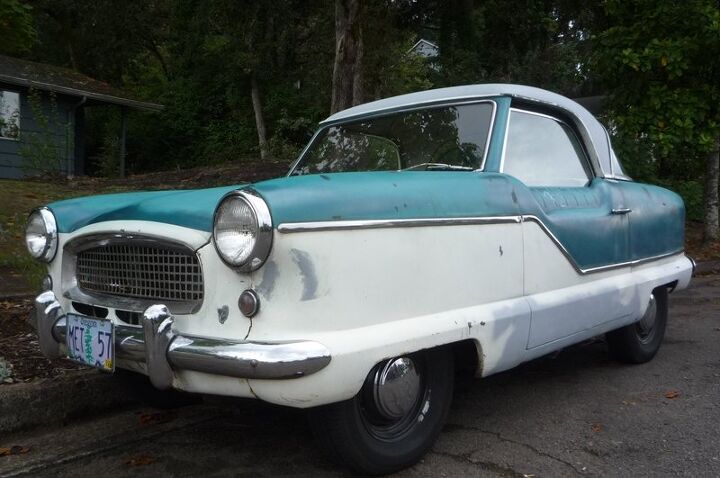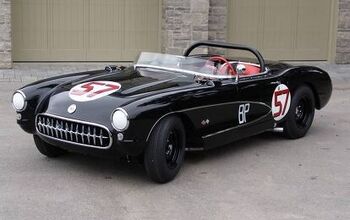Curbside Classic: 1957 Metropolitan

Americans generally just don’t take too well to tiny cars. Perhaps they’re too much like toys, not really yet grown up? The Metropolitan certainly looks the part, resembling an amusement park ride or clown car rather than a genuine automobile a self-respecting grown-up American would drive. And this particular Metro only reinforces that stereotype: it’s owner is fourteen, and he’s owned it since he was ten. “Dad, can I have this cool car?”
If you’re Russel, you’re in luck. He saw it sitting forlorn for years in a neighbor’s carport, and at the age of ten, he talked his dad into buying it for him. And who says kids aren’t into cars anymore? Just depends on the ride.
It’s not like Russel was exactly the target demographic Nash’s George Mason had in mind in the late forties, when he got the small car bug. A bit surprising too, coming on the heels of the failure of the tiny Crosley. Well, Mason initially had in mind something much more substantial than that little flea, and the result was the 1950 Rambler, the first “compact” of the post-war era.
Wisely, Nash positioned it is a “premium” compact, with a roll-back top and well equipped. There simply wasn’t enough difference in the cost of building a compact from a full-sized car to allow it to be sold for much less, so the Rambler broke new ground with an upscale approach. It worked well enough in moderate numbers to encourage Nash to go even a step smaller.
Designer Bill Flajole (above) was thinking along the same lines, and when he hoked up with Nash, their joint ideas on the subject were expressed in the NXI prototype of 1950. One of the key aspects of the design was to save money on large body stampings, since it was assumed the little car would not likely be a large volume job. Note the symmetrical door, which made it into the production Metro. To my knowledge, the fenders on the prototype were also symmetrical, except for the minor cutout for the front wheel. Symmetry as a way to reduce tooling costs was a recurring theme, especially at AMC, even into the sixties, when the prototype for the Hornet ( Cavalier) tried the same approach.
Mason was intrigued, but not enthusiastic about what it would take to actually produce it, profitably. The solution was outsourcing: with the devaluation of the British pound, having the Metro built in England made it viable. The firm Fisher & Ludlow, Ltd. built the body, and Austin supplied and installed the running gear, whose cars were already fairly common in the US as imports.
The 1954 Metro went on sale for about $1500 ($12k adjusted), pretty much the same as a Smart today. It used the popular 1500 cc B-block motor in 42 hp tune, and a three-speed with a column shifter. Given its light weight of some 1800 lbs, the Metro performed adequately, but then it was never positioned as a sports car. The suspension was tuned more for ride than handling. An MG in drag it was not.
Sales for the Metro were modest, bouncing around in the teens of thousands most of the years it was produced, from 1954 through 1960. The Big Three’s new compacts that final year put the kibosh on the Metro, but it’s had an enthusiastic following ever since, especially the young or young at heart.
My older brother (very much young at heart) went through a couple of these back in the late seventies, when they could be picked up for a song. His experiences keeping an MGA running years earlier came in handy, since they used the same basic motor and other BMC goodies and Lucas electrics. But their simplicity and availability of parts makes them a fun project, like for Russel and his dad.
The motor in this one is all original, and good to go. They’ve done some repair work to get the Metro back on the street, but like a good little CC, it is as original as possible, and shows it too. Russel has a lifetime of fun and improvements ahead of him. And, yes, he has put in some behind-the-wheel time in the Metro, despite his age, in undisclosed locations.
The Metro gets lots of attention, wherever it goes. Russell is looking forward to the Metro’s magnetic appeal to the opposite sex, just as soon as he can take advantage of it. Picking up girls with his dad along is a bit compromising, since that back “seat” is more than a bit cramped, even for limber young bodies.
The Metro found a modest following for a few years, as did the Crosley in the forties. And the Smart is going down that same road; in fact its sales are pretty much in Metro territory. But the euro is a lot stronger today than the pound was in 1954, so although Nash made a modest profit from the Metro, the same is not the case for the Smart. And of course, the little Crosley just didn’t catch on either. Toy cars, all of them. And they want to raise the driving age?
PS: atewithmotor has an excellent detailed history of the Metro, for those wanting a more serious look at it.

More by Paul Niedermeyer
Latest Car Reviews
Read moreLatest Product Reviews
Read moreRecent Comments
- Mebgardner I test drove a 2023 2.5 Rav4 last year. I passed on it because it was a very noisy interior, and handled poorly on uneven pavement (filled potholes), which Tucson has many. Very little acoustic padding mean you talk loudly above 55 mph. The forums were also talking about how the roof leaks from not properly sealed roof rack holes, and door windows leaking into the lower door interior. I did not stick around to find out if all that was true. No talk about engine troubles though, this is new info to me.
- Dave Holzman '08 Civic (stick) that I bought used 1/31/12 with 35k on the clock. Now at 159k.It runs as nicely as it did when I bought it. I love the feel of the car. The most expensive replacement was the AC compressor, I think, but something to do with the AC that went at 80k and cost $1300 to replace. It's had more stuff replaced than I expected, but not enough to make me want to ditch a car that I truly enjoy driving.
- ToolGuy Let's review: I am a poor unsuccessful loser. Any car company which introduced an EV which I could afford would earn my contempt. Of course I would buy it, but I wouldn't respect them. 😉
- ToolGuy Correct answer is the one that isn't a Honda.
- 1995 SC Man it isn't even the weekend yet













































Comments
Join the conversation
One of my grandparents worked for Nash when this came out. I always wished he had bought one and hung on to it for sentimental reasons. But of course for him it was probably just another car he worked on, and the cheapest, smallest one in the line at that. They only owned one car as the family car since he always drove fleet cars to and from work (often some weird foreign subcompact from the research pool according to Mom). A Met would not have made a good family car and a second car "just for fun" would have caused the Frugal Scot portion of his blood to reject his brain as an organ. Actually what he usually ended up buying was a wagon - Airflytes, Classics, Ambassadors, and his final AMC - a 1977 Firecracker Red Pacer wagon (yes, with basketry print upholstery and woodgrain accents). Wouldn't mind having any one of those either. When I was a kid he had an early '70s Ambassador he called "The Big Yellah Car" that was pretty cool. Instead, when he died he left behind a [nod]off-white, Arizona-garaged, low mile, 1st generation Chevrolet Cavalier wagon with few options, blown struts, and no brakes. Yeah... nobody fought over that after the funeral.
My Metro, which, by the way, was the same color as the one above, had a strange thump from the driver's door when going around corners. I finally pulled off the inner door panel and found a heavy steel backing block that a worker would use to pound out steel. Some assembler in England probably wondered where his tool had disappeared to. It was obvious that some "southern engineering" was needed to make parts fit. I still have the block in my workshop today, almost 60 years later.